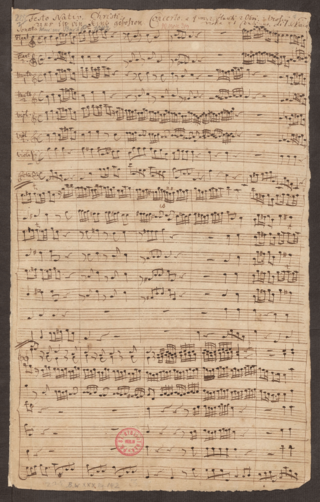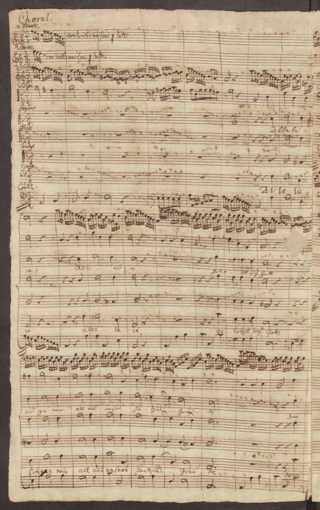Uns ist ein Kind geboren, BWV 142 facts for kids
Uns ist ein Kind geboren (Unto us a child is born), BWV 142 / Anh. II 23, is a Christmas cantata by an unknown composer. In the Bach-Werke-Verzeichnis it is listed among the works with a doubtful attribution to Johann Sebastian Bach. The text is based on a libretto by Erdmann Neumeister first published in 1711. Although attributed to Bach by the Bach-Gesellschaft when they first published it in the late nineteenth century, that attribution was questioned within thirty years and is no longer accepted. Johann Kuhnau, Bach's predecessor as Thomaskantor in Leipzig, has been suggested as the probable composer, but without any certainty.
The cantata is in eight movements, and is scored for vocal soloists, choir, recorders, oboes, strings and continuo.
Contents
Movements
The cantata is scored for three vocal soloists (alto, tenor and bass), a four-part choir, two alto recorders, two oboes, two violins, viola and continuo.
The piece has eight movements:
- Sinfonia, an instrumental concerto for two alto recorders, two oboes and strings.
- Chorus: Uns ist ein Kind geboren (For unto us a child is born), a double fugue with the first theme set to the text "Uns ist ein Kind geboren" and the second set to "Eins Sohn ist uns gegeben".
- Aria (bass): Dein Geburtstag ist erschienen (So appears the Natal day). In this aria in E minor the bass is accompanied by two obbligato violins and continuo.
- Chorus: Ich will den Namen Gottes loben (I will praise the name of God). This short choral movement begins with a fugato section in which the four vocal parts are accompanied by the first and second violins. After the fugal entries, the music is homophonic.
- Aria (tenor): Jesu, dir sei Dank (Jesus, thanks be to you). In this relatively short da capo aria, the tenor is accompanied by two obbligato oboes.
- Recitative (alto): Immanuel (Emmanuel!)
- Aria (alto): Jesu, dir sei Preis (Praise be to you, Jesus). Set to new words, this aria is a transposition of the 5th movement from A minor to D minor, with the alto replacing the tenor and the two alto recorders replacing the oboes.
- Chorus: Alleluia. Over an almost uninterrupted stream of semiquaver figures played in unison by alto recorders, oboes and violins, the choir sings the final four-part chorale line by line.
Translations
In 1939, Sydney Biden provided the English translation for the cantata For us a child is born.
Arrangements
In 1940, William Walton orchestrated the first bass aria in the cantata as dance music for Frederick Ashton's ballet The Wise Virgins. Arrangements of the final chorus for organ and one or more brass instruments have been published separately.
Recordings
Recordings of the cantata include:
- Alsfelder Vokalensemble / I Febiarmionici, Wolfgang Helbich. The Apocryphal Bach Cantatas II. CPO, 2001.
- Choir and Orchestra "Pro Arte" Munich, Kurt Redel. J. S. Bach: Magnificat in D Major & Cantata BWV 142. Philips, 1964.
- Mannheim Bach Choir / Heidelberger Kammerorchester, Heinz Markus Göttsche. J. S. Bach: Cantatas BWV 62 & BWV 142. Da Camera, 1966.
- Capella Brugensis / Collegium instrumentale Brugense, Patrick Peire. 'Uns ist ein Kind geboren', Eufoda, 1972
See also
 In Spanish: Uns ist ein Kind geboren, BWV 142 para niños
In Spanish: Uns ist ein Kind geboren, BWV 142 para niños



